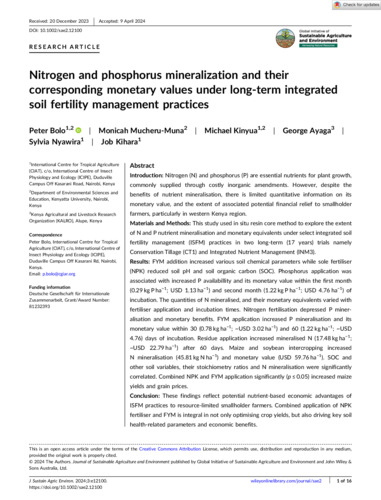Nitrogen and phosphorus mineralization and their corresponding monetary values under long‐term integrated soil fertility management practices
Abstract Introduction Nitrogen (N) and phosphorus (P) are essential nutrients for plant growth, commonly supplied through costly inorganic amendments. However, despite the benefits of nutrient mineralisation, there is limited quantitative information on its monetary value, and the extent of associated potential financial relief to smallholder farmers, particularly in western Kenya region. Materials and Methods This study used in situ resin core method to explore the extent of N and P nutrient mineralisation and monetary equivalents under select integrated soil fertility management (ISFM) practices in two long‐term (17 years) trials namely Conservation Tillage (CT1) and Integrated Nutrient Management (INM3). Results FYM addition increased various soil chemical parameters while sole fertiliser (NPK) reduced soil pH and soil organic carbon (SOC). Phosphorus application was associated with increased P availabillity and its monetary value within the first month (0.29 kg P ha −1 ; USD 1.13 ha −1 ) and second month (1.22 kg P ha −1 ; USD 4.76 ha −1 ) of incubation. The quantities of N mineralised, and their monetary equivalents varied with fertiliser application and incubation times. Nitrogen fertilisation depressed P mineralisation and monetary benefits. FYM application increased P mineralisation and its monetary value within 30 (0.78 kg ha −1 ; ~USD 3.02 ha −1 ) and 60 (1.22 kg ha −1 ; ~USD 4.76) days of incubation. Residue application increased mineralised N (17.48 kg ha −1 ; ~USD 22.79 ha −1 ) after 60 days. Maize and soybean intercropping increased N mineralisation (45.81 kg N ha −1 ) and monetary value (USD 59.76 ha −1 ). SOC and other soil variables, their stoichiometry ratios and N mineralisation were significantly correlated. Combined NPK and FYM application significantly ( p ≤ 0.05) increased maize yields and grain prices. Conclusion These findings reflect potential nutrient‐based economic advantages of ISFM practices to resource‐limited smallholder farmers. Combined application of NPK fertiliser and FYM is integral in not only optimising crop yields, but also driving key soil health‐related parameters and economic benefits.

